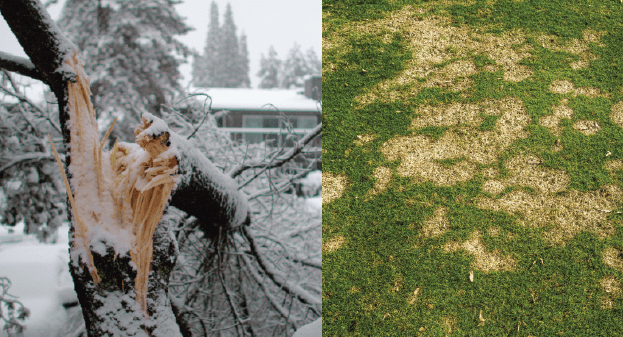Spring is almost in full bloom, which means it’s time to start thinking about your landscaping. Winter can be tough on your plants and trees, so it’s important that you make sure to inspect them for damage. Two common problems you may encounter are snow mold and winter tree damage. Read on to discover ways to fight against these wintertime threats.
Snow Mold
One of the most common landscaping threats in winter is snow mold. Snow mold is a lawn disease caused by a fungus that both looks like snow and tends to infect grass as actual snow melts. Here’s a quick guide to the threat and how to deal with it.
Types of Snow Mold
There are two types of snow mold: gray snow mold and pink snow mold. Gray snow mold is more common in colder climates and requires the presence of snow while pink snow mold is more common in warmer climates and can be identified with a pink ring around a dead patch of grass. Unlike grey snow mold, the presence of snow is not a necessary cause. The form of the mold itself looks similar to snow, which is why it gets its name. It’s also caused by snow, usually occurring when the snow has sat on the grass for too long.
Clearing Snow
Because snow causes snow mold, the easiest way to handle it is to clear snow. You won’t need to go out right away and start shoveling during a blizzard, as snow mold takes days to grow.
However, snow isn’t the only cause. Snow mold grows in wet conditions beneath 30-60 degrees Fahrenheit.
Fighting Snow Mold
If you have snow mold, you can usually just wait it out! Snow mold goes away when the temperatures are no longer suitable for growth.
If the mold remains much longer than it should, you might want to sod your lawn. Conversely, physically removing the mold or the grass it’s growing on are sufficient ways to mitigate the issue. The best solution is to have an expert landscaping contractor deal with the problem for you!
Tree Damage
Along with snow mold, another common threat in the winter is tree damage.
Prevent Falling Branches
A dominant threat is the build-up of snow on your tree branches. For larger trees with thick, leafy branches, the snow can build up to a dangerous level. Eventually, the branch may break, carrying the snow with it.
Dead branches also are at a much higher risk of falling. Consider having your trees trimmed before winter to combat this.
Protect Tree Saplings
Young trees are especially vulnerable during winter. They often don’t have the security that larger trees have from temperature-regulating thick barks and branches. Their roots are also less deep, making them easier to knock over. Consider winter watering to maintain the plant vigor and help them leaf out in spring.
Young thin-barked trees and newly planted trees can be protected with tree wrap to help them sustain the temperature fluctuations that are common in Colorado. It is not unusual to experience 40-degree temperatures swings from 60+ degrees to below freezing in 24 hours. These “Freeze” events kill the plant cells and result in a complete failure or significant die bark throughout the trees or shrubs.
Snow mold and tree damage are just a few winter issues that can occur to landscapes. By following these tips, you can keep your yard safe from the winter elements to ensure a beautiful landscape in the spring.
For more tips, feel free to contact us or browse our extensive website to learn more.
To learn more about our Landscaping services, contact Denver Commercial Property Services today!



